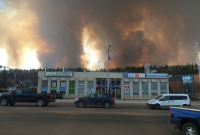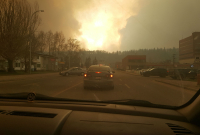Support strong Canadian climate journalism for 2025
The operator of Canada's largest synthetic crude project in the oilsands near Fort McMurray has halted operations to protect its workers after its facilities were surrounded by smoke from this week's devastating wildfire.
Syncrude, an oilsands mining and upgrading project that produces about 326,000 barrels-per-day of crude oil, announced early Saturday that it would evacuate its facilities at Mildred Lake - about 40 kilometres north of Fort McMurray, and take its operations offline in a "safe and orderly manner."
"There is no imminent threat from fire, however smoke has reached Mildred Lake site," said the company in a statement.
Syncrude, a partnership of several oil companies including Suncor, Imperial Oil and Nexen, said it would continue to pay its 4,800 employees, transporting staff by bus and air through an evacuation that began early in the morning and was expected to continue through the weekend.
The shut down is the latest in a series of oil production disruptions that were provoked by the the rapidly growing wildfire. An estimated one million barrels of daily production, close to 40 per cent of Canada's oilsands output, had already been disrupted around Fort McMurray earlier this week due to the wildfire.
Although the cause of the wildfire is still under investigation, government officials and scientists have said that it rapidly spread due to unseasonably hot and dry conditions, combined with strong winds. The wildfire - covering an area of 156,000 hectares by Saturday morning - jumped over rivers and highways before attacking Fort McMurray in the past week.
The small wildfire was quickly discovered by provincial fire prevention officials when it started one week earlier, but it grew rapidly despite the immediate deployment of four air tankers and helicopters as part of a team of firefighters, said Chad Morrison, an Alberta government wildfire manager.
“It goes to show how hot and dry it has been here, with no rain in the area for the last two months," said Morrison on Saturday at a news conference. "Any fire that starts can grow very quickly and move very fast.”
Scientists say the disaster is consistent with a pattern of devastating extreme weather events that are on the rise due to rising carbon pollution and the resulting climate change. In this case, the end of a strong El Nino - a phenomenon linked to warm Pacific Ocean water that affects the weather - was also considered to be a factor.
Meantime, Syncrude said it would only bring its facilities back online when it determines it to be safe for its employees and its operations.
"Syncrude continues to monitor and assess wildfire activity in the Wood Buffalo region," the company said in its statement. "This includes working with regional partners and engaging external experts on fire modelling."
More than 1,600 building structures and countless vehicles were severely damaged or destroyed, but firefighters say they managed to save some of the city's critical infrastructure, including its water treatment plant, the hospital and buildings in the downtown core. The fire was moving away from the city, but continuing to grow, increasing in size by nearly 50 per cent overnight and occupying an area that would be larger than the city of Calgary.
Officials expected it would continue moving east and reach Saskatchewan toward the end of the day on Saturday.
"In no way is this fire under control," said Alberta Premier Rachel Notley.
Provincial officials said there were 40 wildfires burning in Alberta as of Saturday, including seven that were out of control. Alberta firefighters had also begun attacking one wildfire from that was spreading from British Columbia.
In total, more than 1,400 firefighters, about 133 helicopters, 295 pieces of heavy equipment and more than 27 air tankers were deployed in the wildfire battle across Alberta, with several cities remaining under a mandatory evacuation order.
Notley, who told Fort McMurray residents earlier this week that they would need to brace for a long wait before finding out whether it was safe for them to return home, said there was a lot of work to do in assessing the damage.
“The gas has been turned off, the power grid has been damaged and large portions of the city don't have power right now," Notley said. "The water is not currently drinkable. There are no stores open. There’s a great deal of hazardous material to be cleaned up and many other things to be done before the city is safe for families to go home.”







Comments